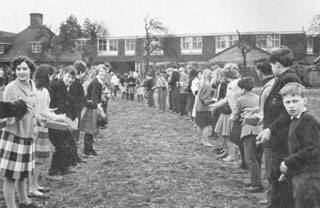
 |
Back to start |
The response to this appeal was rapid and enormously encouraging. We were lent a bench and a pipe bender for bending reinforced steel; one parent lent a number of shovels, another made the splendid gift of 3,500 bricks. Others did valuable work in seeking out secondhand building material. One enabled the school to buy 220 railway sleepers, weighing 16 tons, to form a track to the site that would stand up to hard usage by heavy lorries, and also made a gift of timber bought from a closed-down railway line in Hampshire. Other offers of loan included a 4-ton lorry, a cement mixer and a tractor; gifts included paving, 500 sheets of Fablon plastic, piping and cement. Through the vigilance of a school parent, three second-hand filtration tanks were bought for the remarkably low price of £45 each (they might each have cost £150 new), and an automatic burner was acquired from a glove factory for £50.
One problem to be faced was that of a suitable "water bar" to be inserted at all joints in the concrete; the Engineer decided to use Poly Vinyl Chloride instead of the customary copper or steel, thus saving something like £200. An old pupil of the School who was Pit Manager of a Yorkshire Colliery offered to supply old Coal Board conveyor belting, which could be sliced into 6 in. strips, at a cost of 12/- per cwt., and a sample was sent to undergo tests at Cambridge. It proved thoroughly satisfactory, and it was joined with Bostick sealing compound.

|
Brick passing, Autumn 1961. |
| Back to previous. | Continue to next page. |
| Back to start | |